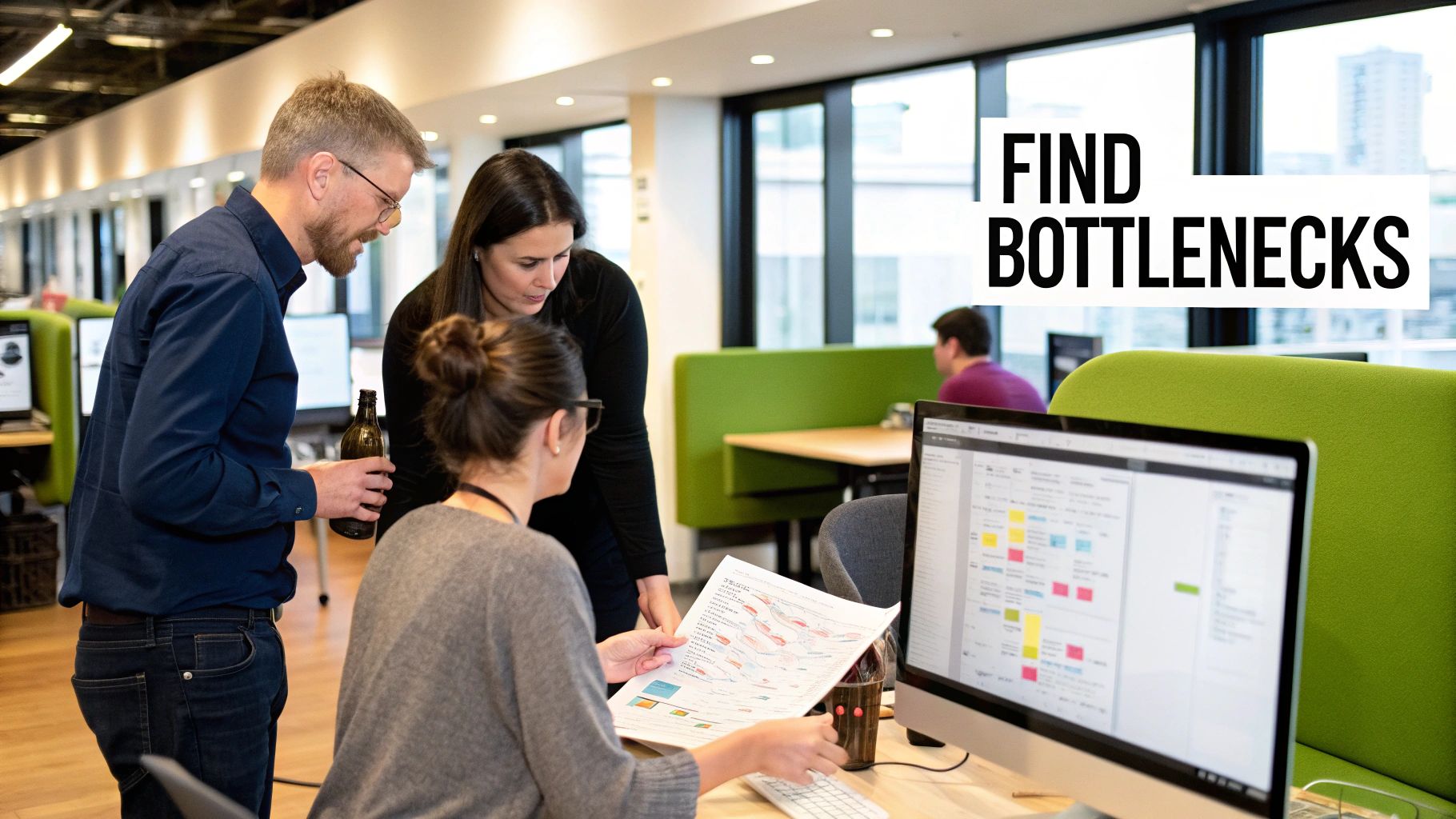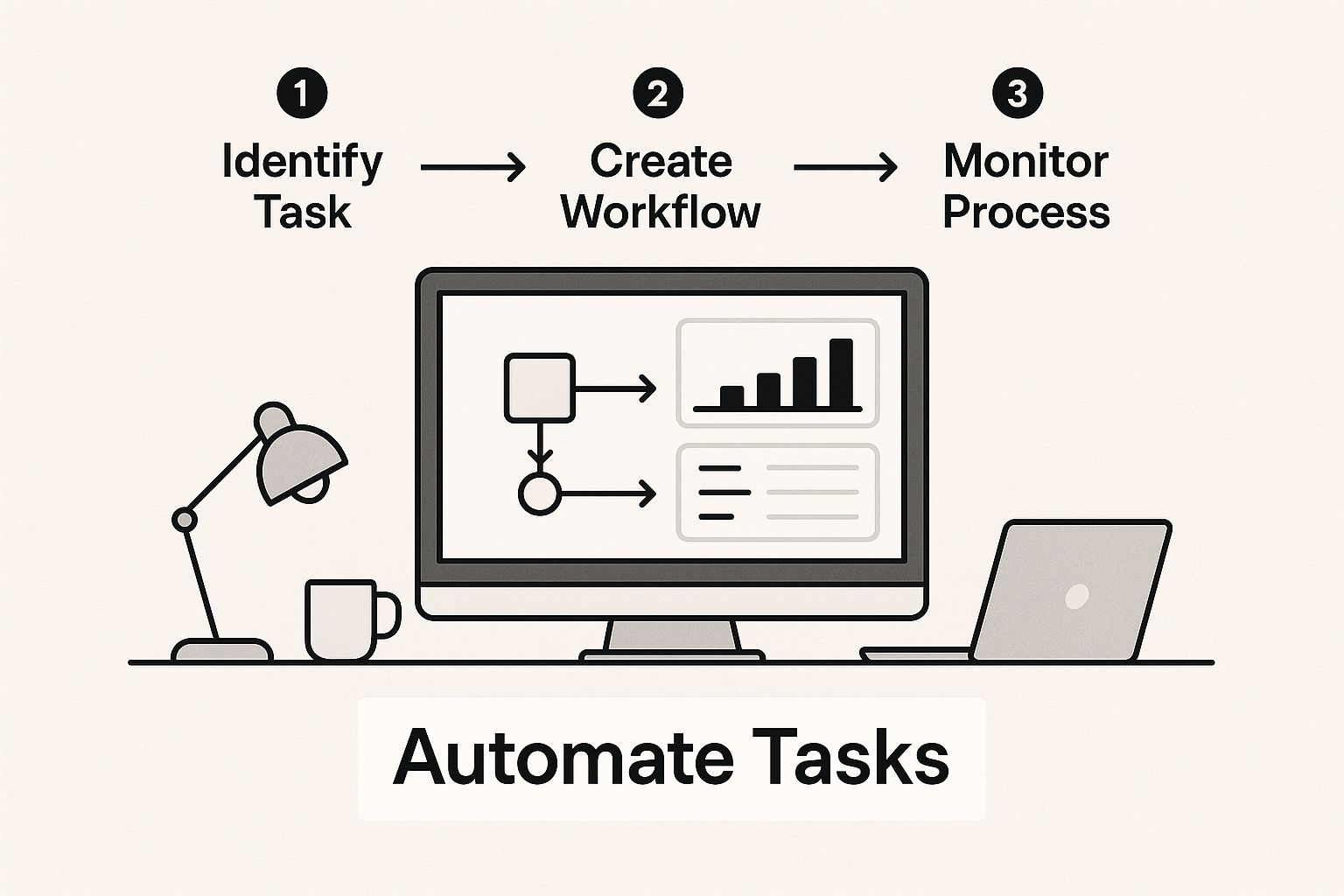Table of Contents
Boosting your business's efficiency isn't about slapping on a few quick fixes and calling it a day. The real, lasting gains come from building a resilient, adaptable operational model from the ground up. It’s about weaving together your people, processes, and technology to drive sustainable growth—moving past simple cost-cutting to create a genuine competitive edge.b
Building a Foundation for Lasting Business Efficiency

In a world where market disruptions are the new normal, efficiency is no longer just a nice-to-have; it's a strategic must. It's the engine that powers everything from your financial health to customer satisfaction and even how engaged your employees are.
A genuinely efficient business doesn't just do things faster. It does the right things smarter. This means cutting out the waste and focusing your team’s precious time and resources on activities that truly move the needle.
To get there, you need a shift in mindset. Stop thinking of efficiency as a one-off project. Instead, see it as part of your company's DNA—a system where continuous improvement is just how you operate, backed by clear processes and empowered teams with the right tools for the job.
The Three Pillars of Sustainable Efficiency
Lasting efficiency is built on three core pillars: a healthy operational core, smart investment in your workforce, and a relentless focus on customer-centric innovation. When these three work in sync, they create a flywheel of growth and stability. But if one is weak, it'll drag the others down and stall your progress.
A global survey of business leaders drove this point home. It found that companies seeing a profit margin jump of 5% or more were also 1.3 times more likely to have highly engaged workforces. This reveals a critical truth: investing in your people's development and performance directly fuels your bottom line.
This data shows that the most profitable companies aren't just blindly cutting costs. They're making strategic bets on the systems and people that will make them more agile and effective for the long haul.
Creating a Practical Roadmap
To put all this into practice, you need a clear plan. Building a strong foundation often starts with implementing solid systems for managing multiple projects effectively, which helps prevent bottlenecks and keeps everyone on the same page. From that solid base, you can start identifying specific areas ripe for improvement.
Think of this guide as your roadmap. We’re going to walk through actionable strategies, including:
- Process Mapping: Visually charting your workflows to see exactly where the friction and holdups are hiding.
- Automation & AI: Using technology to take over repetitive tasks, freeing up your team to focus on more strategic work.
- Workflow Optimization: Fine-tuning the way work gets done to boost both speed and quality. For a deep dive into a specific area, you can learn how to https://typethink.ai/blog/master-your-content-creation-workflow-for-better-results in our other guide.
By embracing these strategies, you can start building a more efficient, profitable, and resilient organization—one that's ready for whatever comes next.
Map Your Processes to Uncover Hidden Bottlenecks
You can't fix a problem you don't know you have. That’s the real challenge when you’re trying to boost business efficiency. Inefficiencies are rarely obvious; they’re usually buried in the daily routines your team has followed for years, hiding in plain sight. This is where business process mapping becomes your secret weapon.
Think of it as creating a detailed blueprint of a workflow from start to finish. It’s like drawing a map of a river, showing every single twist, turn, and tributary. This visual guide lets you see the entire journey a task takes, exposing all the hidden rocks and rapids—the bottlenecks, redundant steps, and communication gaps—that are slowing you down.
Why You Must Start with a Map
Jumping straight into buying new software or overhauling a department without a map is like trying to navigate a new city without GPS. You might get where you’re going eventually, but you'll waste a ton of time and energy on wrong turns. A clear process map gives you the data-driven foundation you need to make smart, targeted improvements.
Instead of just guessing where the problems are, you get hard evidence. I’ve seen this firsthand: a sales team discovered they were spending 30% of their time just on manual data entry after client calls. That's a huge, measurable inefficiency that, once identified, could be solved with simple automation, freeing them up to do what they do best—sell.
By visualizing the workflow, you create a single source of truth that everyone can see and agree on. It gets the whole team on the same page and sets the stage for productive conversations about real change.
How to Create Your First Process Map
Getting started with process mapping doesn’t require a huge budget or fancy software. Honestly, you can kick things off with a whiteboard, a pack of sticky notes, and the right people in the room. The most crucial part? Involving your frontline team—the employees who live and breathe the process every single day. They have the ground-level insights you’ll never find on a spreadsheet.
Here’s a practical way to get going:
- Pick a Core Process: Don't try to map your entire business at once. Start with one high-impact or notoriously clunky workflow, like customer onboarding, invoice processing, or fulfilling an e-commerce order.
- Assemble the Team: Get everyone involved in that process into a room, from start to finish. Their collective knowledge is gold.
- Document Every Step: Use sticky notes to represent each task, decision, and handoff. Lay them out chronologically on the whiteboard. A task could be "Enter new client info into CRM," while a decision might be "Is the order over $1,000?"
- Connect the Dots: Now, draw lines between the notes to show how work actually flows. This is where the magic happens. You’ll quickly see where work gets stuck, where approvals cause delays, or where information gets passed back and forth needlessly.
This visualization shows how automation, a key outcome of good process mapping, becomes a natural next step in a modern workflow.

As the image highlights, once you’ve laid out your processes and identified that repetitive grunt work, dedicating resources to automation becomes the obvious move for real efficiency gains.
Analyzing Your Map for Actionable Insights
Once your map is up on the wall, the real work begins. Stand back with your team and really look at the flow you’ve created. Hunt for the common culprits of inefficiency. For example, a marketing agency I worked with mapped their content process and was shocked to find that a single blog post went through seven different approval stages before going live. No wonder they were always behind schedule.
When you're dealing with a complex process, it can be invaluable to learn how to master your content creation workflow. This kind of structured thinking helps you break down big projects into clear stages, making it much easier to fix the bottlenecks your map just revealed.
Look for these patterns in your own maps:
- Redundant Tasks: Is your team entering the same data into multiple systems?
- Bottlenecks: Where does work consistently pile up, waiting for one person or resource?
- Murky Handoffs: Does confusion pop up whenever a task moves between people or teams?
- Approval Overload: Are too many sign-offs bogging down minor decisions?
By asking these questions, you turn a simple diagram into a powerful action plan. Each inefficiency you spot becomes a clear target for improvement, ensuring you invest your time and resources where they’ll make the biggest impact.
Free Up Your Team by Automating the Grunt Work

After mapping out your processes, you’ll start to see a clear pattern behind your biggest bottlenecks: repetitive, manual tasks. This is where automation stops being a buzzword and becomes a practical, powerful tool for your business. It’s all about strategically taking those mind-numbing, time-sucking jobs off your team's shoulders.
Let's be clear: the goal isn't to replace people. It's to free them up.
Think about how much time your skilled employees waste on data entry, sending reminder emails, or pulling the same report every week. Automating these tasks lets them focus on work that actually requires a human touch—critical thinking, creative problem-solving, and building relationships. That’s the work that truly moves the needle.
This isn’t just a feel-good idea; it has a massive financial impact. The workflow automation market is expected to skyrocket to $80.9 billion by 2030. It’s a strategic investment in your people, too. According to research from Vena Solutions, 89% of employees are happier at their jobs because of automation, and 84% feel better about their company as a whole.
Find Your Quick Wins: Where to Automate First
The smartest way to start is by targeting high-impact, low-complexity tasks. These are your "quick wins"—the automations that deliver real results without a massive, complicated rollout.
Honestly, the best way to find them is to just ask your team. Pull them aside and ask, "What’s the one task you do every day or week that you absolutely dread?" Their answers will give you a perfect roadmap.
From my experience, most businesses find gold in areas like:
- Manual Data Entry: Think about copying customer info from a contact form into your CRM or moving order details from your e-commerce platform to your accounting software.
- Invoice Chasing: Automatically generating and sending invoices, then following up on late payments without anyone lifting a finger.
- Customer Follow-Up: Sending out standardized welcome emails, appointment reminders, or feedback surveys.
- Social Media Scheduling: Pushing out pre-approved content to all your channels at the best possible times.
If you run a service-based business, our guide on how to automate repetitive tasks is the perfect agency growth playbook offers a much deeper look into these specific opportunities.
The Right Tools for the Job
You don't need a computer science degree to get this done. Modern tools are built for business users, not developers. A great example is Robotic Process Automation (RPA), which uses software "bots" to mimic what a human does on a computer—clicking, typing, and moving data between apps.
These tools are also surprisingly affordable. An RPA bot can operate at about one-third the cost of an offshore employee and just one-fifth that of an onshore one. This makes powerful automation totally achievable, even for small businesses.
To get you thinking, here’s a breakdown of common, high-value tasks you can automate across your company to see an immediate boost in efficiency.
High-Impact Automation Opportunities By Department
This table just scratches the surface, but it shows how targeted automation can solve real, everyday problems and free up a surprising amount of time.
Make Automation Part of Your Company DNA
Putting a few automations in place is a great start, but the real magic happens when it becomes a part of your culture. It's a shift in mindset—from working harder to working smarter. Encourage your team to think of automation as a digital assistant that handles the boring stuff so they can focus on what they were actually hired to do.
My advice? Start small. Pick one department and launch a pilot project. Track the time saved, the reduction in errors, and the boost in morale. Then, shout those results from the rooftops. When other teams see the real-world benefits, they'll be clamoring to find their own automation opportunities. This creates a ripple effect that improves efficiency across the entire business.
Bring AI in to Supercharge Your Team
Let's get one thing straight: AI isn't here to replace your talented people. It's a tool—a powerful one—that can partner with your team to make them better, faster, and more focused. Think of it as the ultimate assistant, taking over the monotonous, data-heavy tasks that slow everyone down. This frees up your team's brainpower for the things that really matter: strategic thinking, creative problem-solving, and building genuine customer relationships.
Instead of getting lost in a sea of spreadsheets, your analysts can have an AI partner sift through mountains of data to spot critical trends in minutes. Your marketing team can stop staring at a blank page and instead use generative AI to brainstorm initial copy, social media posts, or email drafts, getting a solid starting point in seconds.
The numbers don't lie. AI adoption is exploding, jumping from around 50% between 2020 and 2023 to 72% today. And the results are compelling: an incredible 92.1% of businesses using AI are seeing real, measurable boosts in productivity. You can see more on how AI is changing the game on Superhuman's blog.
So, Where Do You Start?
Diving into AI doesn't mean you need to go on a hiring spree for data scientists. The smartest way to begin is by starting small. Find a nagging, high-friction problem that’s currently eating up your team's time and resources, and aim an AI tool right at it.
A classic example I see all the time is in customer support. An AI-powered chatbot can be a game-changer, handling the same common questions over and over, 24/7. This doesn't make your support staff obsolete; it empowers them to focus on the complex, high-value customer issues that truly require a human touch.
Content creation is another fantastic place to get a quick win. Imagine your marketing manager using an AI tool to:
- Whip up ten different headline options for a blog post.
- Summarize a dense, 20-page report into a punchy social media update.
- Draft a personalized follow-up email sequence for webinar attendees.
Of course, the AI's output is just the first draft. A human still needs to step in to refine, edit, and inject the brand's unique voice and strategic insight. It’s this human-AI collaboration that really works.
This approach delivers quick, tangible wins, which builds confidence across the company. It makes it much easier to get buy-in for bigger AI projects down the road, shifting the conversation from a risky overhaul to a series of smart, incremental improvements.
Practical AI Plays for Your Business
Let's get down to brass tacks. How can different departments actually use AI to work more efficiently? The applications are incredibly varied, but the core idea is always the same: let the machine handle the repetitive, data-driven work to unleash your team's true potential. For a deeper dive, our guide on AI workflow automation provides a complete business playbook that you'll want to check out.
For now, here’s how AI can slot into your existing teams.
For Your Sales and Marketing Teams
- Predictive Lead Scoring: Instead of guessing, AI can analyze past sales data and customer behavior to pinpoint which leads are most likely to buy. This helps your sales reps focus their energy on the hottest prospects, which can seriously improve close rates.
- Smarter Content Personalization: Ditch the generic email blasts. AI can tailor marketing messages to individual customers based on their past purchases and browsing habits, making your campaigns feel more personal and effective.
For Your Operations and Finance Teams
- Accurate Demand Forecasting: An e-commerce store can use AI to analyze market trends, seasonality, and even social media chatter to predict product demand with stunning accuracy. This means no more costly overstocking or frustrating "out of stock" notices.
- Real-Time Fraud Detection: AI algorithms can monitor transactions as they happen, flagging suspicious activity with a speed and precision no human could ever match. This is a simple way to protect your bottom line.
Cultivating an AI-Ready Culture
Here's the truth: successful AI adoption is just as much about your people as it is about the technology. You need to build a culture of curiosity where employees feel encouraged to play with new tools without the fear of messing up.
Start by giving your team access to user-friendly AI platforms. Run training sessions that skip the technical jargon and focus on solving the real-world problems they face every day. Frame AI as a new skill that will make their jobs more strategic and valuable, not as a threat.
When you empower your team to be part of the AI journey, they become your biggest champions. They'll be the ones discovering new and creative ways to apply the technology, creating a continuous cycle of improvement that will keep your business ahead of the game. The data shows this works: 56% of early AI adopters have already blown past their initial business goals.
Fine-Tune Your Communication and Collaboration
I've seen it time and time again: nothing kills momentum faster than a messy communication system. When your team is lost in a sea of email chains, random direct messages, and department-specific chat groups, work doesn't just slow down—it fractures. If you’re serious about boosting business efficiency, you have to get everyone working from a single, organized playbook.